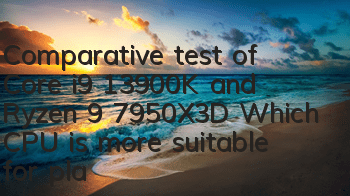In the previous article "Ryzen 9 7950X3D First Release Review", we have introduced AMD's latest top processor equipped with 3D V-Cache technology in detail. Ryzen 9 7950X3D and used Intel's Core i9-13900K to compare and evaluate it.
I believe that everyone has a deeper understanding of these two processors.
However, at that time, in order to reflect the powerful performance of the processor, most of the games we tested were stand-alone masterpieces. You should know that in addition to stand-alone masterpieces, the online game player group cannot be ignored, so at the end we dug a hole - "The games we tested this time are mainly based on 3A, and we will continue to evaluate popular online games (note: the online games here refer to games that can be online based on the Internet) to deeply explore the performance of 7950x3d."
Now, it's time to fill in the pit. In this test, we selected 12 popular online/stand-alone online games that users are more familiar with, and compete with AMD's Ryzen 9 7950X3D and Intel's Core i9-13900K. Let’s see how the two processors will perform in these online games.
Left: Ryzen 9 7950X3D Right: Intel Core i9-13900K
Both processors use LGA packaging, but the AMD processor is designed in a square shape, which can better keep the CPU in a uniform state of stress during the motherboard buckle. Due to the rectangular shape design, Intel is prone to "bending" during the buckle.
Left: Ryzen 9 7950X3D Right: Intel Core i9-13900K
The back of the AMD Ryzen 9 7950X3D is full of contacts, and the capacitor is on the front. The octopus design can improve the heat dissipation performance of the processor, but the application of silicone grease will also become a little more troublesome.
The capacitor of Intel Core i9-13900K is on the back.
Processor specification introduction:
As usual, we made a chart so that everyone can have an intuitive understanding of the two processors.
Both processors are priced at RMB 5,299, but AMD's Ryzen 9 7950X3D adopts a 16-core, 32-thread design. Intel's Core i9-13900K is designed with 8 large cores + 16 small cores with a total of 32 threads.
The advantage of Ryzen 9 7950X is that the third-level cache is 96MB+32MB, a total of 128MB. The third-level cache of Core i9-13900K is 12*3, totaling 36MB.
In terms of power consumption, the default power consumption of the Ryzen 9 7950X3D is 120W (the Ryzen 9 7950X is 170W), which is obviously much lower than Intel's 251W maximum processor power consumption. Lower power consumption also means lower heat generation, so AMD has specially introduced the temperature of this processor - the maximum temperature is 89°C.
Of course, the AMD 7000 series Ryzen processor only supports DDR5 memory, but fortunately, the CPU provides 2 4-speed PCIe 5.0 NVMe M.2 slots (note that it is PCIe 5.0).
Intel 13th generation Core supports DDR5 and DDR4 memory, and the CPU only provides 1 4-speed PCIe 4.0 NVMe M.2 slot (note that it is PCIe 4.0).
AMD Ryzen 9 7950X3D and related memory settings
Thanks to the optimization of memory controllers by AMD 7000 series Ryzen processors, this series of processors can achieve a 1:1 relationship between memory controller frequency and bus frequency. However, due to the motherboard settings, the MSI X670E ACE motherboard we use can only achieve the memory operating frequency of DDR5-6000MHz (the physical frequency is 3000MHz).
It can break through the 6000MHz operating frequency in 1:1 mode on some motherboards. For details, please check the relevant articles of "MSI B650M Mortar Motherboard".
Intel Core I9-13900K and related memory settings
Because Intel has launched the Gear2 mode, Intel is much easier in terms of memory frequency, and it can even reach DDR5-8000MHz or above on some motherboards. However, in order to ensure the test results, we used DDR5-6400MHz memory for this test.
Part 1: Ryzen 9 7950X3D core architecture diagram Next: Core i9-13900K core architecture diagram
Finally, according to convention, we still need to give a brief introduction to the core architecture diagrams of the two processors.
AMD's Ryzen 9 7950X3D's core architecture is almost the same as the Ryzen 9 7950X. However, the processor only uses 3D V-Cache technology on one of the CCDs, adding an additional 64MB of Level 3 cache, making the CCD's Level 3 cache capacity reach an extremely high 32+64=96MB.
As AMD's 7000 series Ryzen processors are designed with a maximum of 8 cores and 16 threads per CCD. Therefore, the Ryzen 9 7950X3D should be - 8 cores share 96MB of level 3 cache, and the other 8 cores share 32MB of level 3 cache.
Intel Core i9-13900K squareThe surface is designed with 8 large cores + 8 small cores, and 4 small cores are 1 group. Thanks to the RingBUS design, the third-level cache of the Core i9-13900K is 12*3MB=36MB.
Introduction to test platform and test project:
Because the main character of the test is two top processors. In order to ensure the stable progress of the test, we should improve other hardware as much as possible. In terms of motherboards, we chose MSI's MEG X670E ACE (God of War) and MPG Z790 CARBON WIFI (Dark).
In terms of graphics cards, we use the graphics card of Souste's RTX 4090 Apocalypse OC, which is currently the top RTX 4090 chipset of NVIDIA.
This test involves 12 online games, including MMORPG, MOBA and even Battle Royale, and FPS games.
Online game test (I):
Note: In order to ensure better performance of the processor, the graphics card used in this test is the RTX 4090 top gaming graphics card.
Comparison of performance performance of "Final Fantasy 14" Benchmark game
Comparison of the performance performance of "Against the Cold" game
Comparison of Benchmark game performance performance of "Zhu Xian World"
Comparison of performance performance of "DOTA2"
Online game test (II):
Note: In order to ensure better performance of the processor, the graphics card used in this test is the RTX 4090 top gaming graphics card.
Comparison of performance performance of "PUBG" game
Comparison of the performance performance of "World of Tanks"
Comparison of the performance performance of "Eternal Damage"
Comparison of the performance performance of "Blockade 2"
Online game test (III):
Note: In order to ensure better performance of the processor, the graphics card used in this test is the RTX 4090 top gaming graphics card.
Comparison of the performance performance of "Rainbow Six: Siege"
Comparison of performance performance of "Glory War Soul" game
Comparison of the performance performance of "Call of Duty: Warzone 2"
Comparison of the performance performance of "Forza Horizon 5"
Test score compilation:
As usual, we listed a comprehensive performance table for the tested games so that everyone can have an intuitive understanding of the game performance of the two processors.
Among the 12 test games, there are 8 leading games for AMD Ryzen 9 7950X3D, and 4 leading games for Intel Core i9-13900K.
Test impressions:
Overall, AMD's Ryzen 9 7950X3D has performed better than previous first-time reviews. Unlike the previous tests that were mostly stand-alone games, online games have multiple people involved and AI-equipped NPCs are added to the scene, which requires a lot of modeling and calculations.
The same is true for the picture we see. The CPU first performs calculations, and then handes the calculation results to the graphics card for rendering. Therefore, compared with stand-alone games, the CPU demand for multiple players and online games involving more AI operations will be higher.
AMD's Ryzen 9 7950X3D adds 64MB capacity 3D V-Cache cache technology, which can better improve the computing efficiency of the processor, so in this 12 online games, the Intel Core i9-13900K was stabilized with a score of 8 to 4.
And through this test, it is not difficult to find that among the many popular online games, there are already many newer games that can better utilize the advantages of 3D V-Cache technology. Originally, the first Ryzen 7 5800X3D equipped with 3D V-Cache technology has received high praise from players. This time AMD applies this technology to the latest Ryzen 7000 series processors, which is a great addition to the tiger.
As AMD continues to deepen its 3D V-Cache technology, coupled with the optimization of core scheduling by game manufacturers and operating systems, I believe that the Ryzen 9 7950X3D will perform higher performance in the future.









